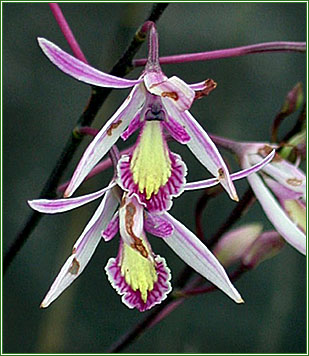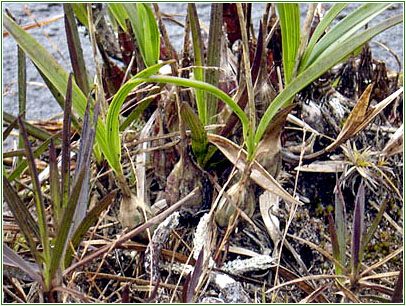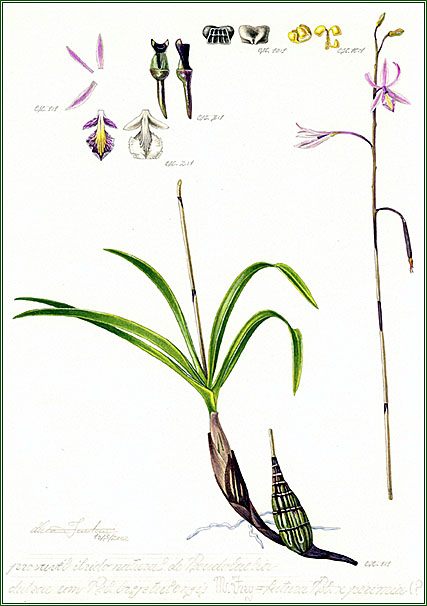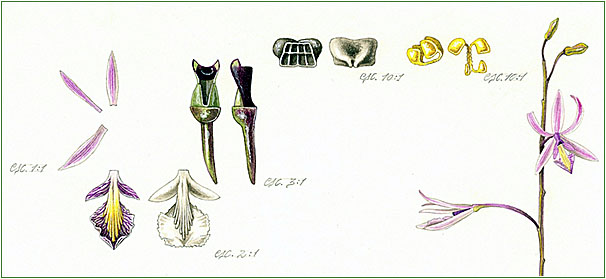 |
Key-words:
Brazil , Espírito Santo, Atlantic Forest,
Orchidaceae, Pseudolaelia.
 |
Abstract
This paper describes Pseudolaelia ×perimii, a natural
hybrid recently discovered in the mountain ranges of Espírito
Santo,Brazil , a crossing between Pseudolaelia brejetubensis
M. Frey and Pseudolaelia freyi Chiron & V.P. Castro.
Information about its ecology and geographic distribution is given
as well as a comparison between the three plants.
Paper originally published in Richardiana Vol. V (3), July 2005, pages
158 a 164.
Monte Feio, a
granitic inselberg in Brejetuba (Espírito Santo, Brazil ) has
already given recently (Chiron & Castro Neto, 2004 ; Frey, 2003)
two new species of Pseudolaelia. It is not a surprise that
we have found a plant which presents the characters of a natural hybrid
between them. Enclosed as the two other to the plaques of lithosol
which are formed towards the peak of the inselbergs, close, if not
tributary of the Velloziaceae which populate them, disappearing
from all eutrophic areas, particularly those invaded by the Poaceae,
this species attracts attention, at the first sight, by its characters
truly intermediate that we will discuss bellow.
Pseudolaelia
× perimii,
M. Frey, Richardiana
Vol V (3) - July 2005 - 158:164
Herba rupicola hybrida naturalis inter Pseudolaelia brejetubensis
M. Frey et Pseudolaelia freyi Chiron & V.P.Castro.
Holotypus: Brazil , Espírito Santo, Brejetuba, Monte Feio,
20° 10’ 35’’ to 20° 11’ S, 41°
16’ 45’’ to 41° 17’ 15’’ W,
altitude 1 100 to 1 400 m, May 2002, M. Frey & L.C.F.Perim 231
(holotypus : MBML). Isotypus : M. Frey & L.C.F.Perim 847 (LY).
Description
Herbaceous plant, in principle lithophyte, sometimes slightly clings
to the close branches of different Velloziaceae. Erect bearing,
30-60 cm tall. Cylindrical rhizome , 3,5 to 5 mm diameter,
2,5 to 5 cm of distance between the pseudobulbs, recovered with numerous
scarious
imbricate
short lasting sheaths; numerous, simples, cylindrical roots
arising along the rhizome, reaching until 15cm tall, 1,5 to 2,5 mm
diameter, white; ovoid pseudobulbs, slightly compressed laterally,
4,5-5,5 × 2,5 cm, formed by 5 internodes, recovered by scarious
sheaths soon caduceous, then smooth, becoming irregularly pluri-veined,
first green with purples blotches, then purple with the age; distic
linear-lanceolate; leaves 2-3 (5), arising in the apex of the
pseudobulb, the inferior much bigger than the superior, reaching 15
cm × 12 mm, folded over the median nervure, acute extremity,
glabra, thin margins and irregularly dentate, green with purple traces
towards the extremity and purple margins, caduceous in a year, at
the level of the abscission, 1 cm bellow the apex of the pseudobulb,
9 parallel nervures visible in transparence; erect inflorescence,
arising from the apex of the pseudobulb, between the leaves; peduncle
persisting dry a year after the blooming, reaching 50 cm tall, slight
compressed laterally, at about 2 ,5 mm wide, 1,5 mm at the beginning
of the rachis, green purple, recovered of 6 to 10 scarious sheaths,
imbricate until the half height, 7 cm long at the base, 2 cm at the
apex; rachis de 10-15 cm, somewhat paniculate (2-3 branches), carrying
until 12 (15) flowers, the branches from 6 to 8; erect, triangle-acute,
membranous, brownish small bracts, 3-4 mm length; pedicel with spread
ovary, reaching until 20 mm length, the pedicel is dark red-purple,
the ovary is darker and somewhat brown; flowers quite opened,
horizontal, 32mm wide, 25mm height, 18 mm depth, light pink with nervures
darker pink margins; sepals reaching until 18-20 mm ×
3 mm, linear-oblong, a little ligulate, with curved borders, acute
extremity, glabra, smooth margins, 3 darker pink nervures, some darker
pink blotches towards the extremity; petals reaching until
18-20 mm × 2 mm, linear-oblong, acute extremity, with a little
curved borders, glabra, smooth margins, darker rose glabra nervure,
smooth margins, dark pink nervure and blotches towards the extremity;
lip 3-lobed, reaching until 15 mm length versus 8 mm wide,
the lateral lobes 10mm spread, lengthening towards the back part by
a nectary fused to the the ovary, round, light purple, at about 1
mm diameter, disc fused to the column until its half, caniculate by
2 big semi-cylindrical calli, white-yellowish with pink borders, lateral
lobes divergent from the axe of the lip in 60°, with a form of
a half moon, turned back, obtuse extremity, 4,5 mm × 2 mm, white
marked with three dark pink branched veins and a dark pink blotch
in the extremity, median lobe slightly unguiculate, small nail 2 mm
× 2 mm, where the calli are attenuated then opening in a wide
oval lobe with undulated and curved margins, light yellow center,
forming 7 calli puberulent, the median is longer which periphery becomes
white with numerous dark pink centrifuge branched veins; column
5 mm length and 3 mm in the extremity, dark green-purple, with
two lateral wings towards the tip, pointed ahead, white greenish,
involving
the ventral stigma
and the anther; terminal darkened purple, having 8 yellow-golden pollinia,
gathered inside 4 juxtaposed boxes, subequal. See figure 1.
Etymology
Named in honor of Luiz Carlos Feitosa Perim who discovered this species.
 figure 1
figure 1 |

figure 1 (detail) |
Habitat
and geographical distribution
The species is found on the same reduced surface of Monte Feio of
Brejetuba where the two species considered as its parents have been
found and described. P. freyi, much more abundant, fills
the totality of the biotypes with thousand plants. P. brejetubensis,
less spread, only occupies a small number of places in this space
and Pseudolaelia ×perimii, as we could expect from
an hybrid between the two, was just found, until now, next to the
place where P. brejetubensis grows. Without being truly vellozicola
as P. freyi, P. ×perimii is accommodate to
the neighborhood of those monocotiledoneas very typical of the biotype
and, sometimes, lean on them.
Discussion
P. × perimii presents many points of the intermediary
characteristics that justifies the thesis. The pseudobulbs, agregate
in P. brejetubensis, are distant, but less than in P.
freyi. In the same way, where the inflorescences of P. brejetubensis
are panicle with numerous branches (from 3 to 6), in P. freyi
there are racemes, with, eventually, a branch which is developed lately,
P. ×perimii have paniculate inflorescences with three
branches, at maximum. The green prominent nectary which is one of
the characteristics more specific of P. brejetubensis reappears
in Pseudolaelia ×perimii, more attenuate, while it
doesn't exist in P. freyi. P. brejetubensis blooms
in April, while as the P. freyi only blooms at the end of
May and mainly in June. P. ×perimii full open mid-May.
Finally, the general aspect of the plant which combines the slenderness
of P. brejetubensis and the rondness of P. freyi,
really allows to think that it is a natural hybrid, phenomenon which
is not rare in the Brazilian southeast where it has been noticed many
times particularly in the Laeliineae group. May be it is
interesting to point out that, after the description of P. brejetubensis,
this species has also been found on Pedra da Invejada, Lajinha County,
in the neighbor state of Minas Gerais. P. freyi was not observed
which reduces the chances of finding a hybrid in this place. In the
same way, P. freyi has been found on another hill in Brejetuba,
but the P. brejetubensis hasn't. Finally, an information
not still confirmed about the occurrence of P. freyi in
a hill of Lajinha, Afonso Cláudio county, in Espírito
Santo, not so far from Feio Hill, however, as P. brejetubensis
has not been observed, it seems to be useless to look for this hybrid.
Nevertheless, there are great possibilities to do news discoveries
in this domain, until now, not very well explored. Withner, in an
paper about Pseudolaelia, written, it is true in 1993 : «
a Brazilian genus not very well known» ! Actually, it seems
that orchidists endeavour are done in the forests and not so frequently
in the peak of the inselbergs. In the same way, there would be a lot
to do in the domain of Bromeliaceae and Velloziaceae,
abundant in those very special biotypes.
Bibliography
Chiron, G.R. & V.P. Castro Neto, 2004. Une nouvelle espèce
de Pseudolaelia (Orchidaceae : Laeliinae)
d’EspíritoSanto (Brésil). Richardiana IV(4) : 156-162
Frey, M., 2003. Pseudolaelia brejetubensis M. Frey (Orchidaceae),
uma nova espécie do Espírito Santo,Brazil . Bradea 9(8)
: 33-36
Withner, C. L., 1993. The Cattleyas and their relatives, vol.3, Timber
Press, Portland (Oregon) USA.
Michel Frey:
sitio Capijuma, Alto Ribeirão do Meio, Conceição
do Castelo, 29375-E.S.Brazil michel_frey@terra.com.br
Photo: Michel Frey
Illustration:
Luca Fontani



